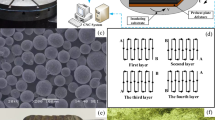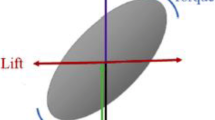Abstract
As an important material, titanium alloy is widely used in the manufacture of aircraft engine parts, and its processed surface quality is critical to the performance of aircraft engines. Abrasive belt grinding (ABG) is a kind of elastic grinding, which plays a significant role in improving titanium alloys’ surface integrity. To validate the mathematical model’s effectiveness from the grinding parameters to the surface residual stress after grinding, firstly, according to the molecular dynamics theory and ABG process, a physical model of titanium alloy ABG molecular system is proposed, and the embedded atom method is chosen as the interatomic potential of titanium alloy. Secondly, combined with the mathematical expression model of residual stress, the surface residual stress is characterized, and the heat correction coefficient is proposed to modify the mathematical model. Finally, based on molecular dynamics, the simulation of grinding residual stress and the grinding experiment is carried out for titanium alloy thin-walled parts. The results of simulation and experiment show that the trend of simulation results is similar to the experiment results. The simulation model can better represent the change rule of ABG surface residual stress for the titanium alloy material, but the average error rate is up to 15.01% due to the systematic error between the two. After correction, the average error rate between the simulation values and experiment values of residual stress on the surface decreases to 4.44%; the effectiveness of the mathematical model is verified.


















Similar content being viewed by others
Data availability
The datasets used or analyzed during the current study are available from the corresponding author on reasonable request.
References
Xi X, Ding W, Wu Z, Anggei L (2020) Performance evaluation of creep feed grinding of γ-TiAl intermetallics with electroplated diamond wheels. Chin J Aeronaut 34:100–109. https://doi.org/10.1016/j.cja.2020.04.031
Huang Y, He S, Xiao G, Li W, Jiahua S, Wang W (2020) Effects research on theoretical-modelling based suppression of the contact flutter in blisk belt grinding. J Manuf Process 54:309–317. https://doi.org/10.1016/j.jmapro.2020.03.021
Xiao G, He Y, Huang Y, He S, Wang W, Wu Y (2020) Bionic microstructure on titanium alloy blade with belt grinding and its drag reduction performance. Proc Inst Mech Eng B J Eng Manuf. https://doi.org/10.1177/0954405420949744
Fan W, Wang W, Wang J, Zhang X, Qian C, Ma T (2020) Microscopic contact pressure and material removal modeling in rail grinding using abrasive belt. Proc Inst Mech Eng B J Eng Manuf 235:3–12. https://doi.org/10.1177/0954405420932419
Miao Q, Ding W, Kuang W, Yang C (2019) Grinding force and surface quality in creep feed profile grinding of turbine blade root of nickel-based superalloy with microcrystalline alumina abrasive wheels. Chin J Aeronaut 34:576–585. https://doi.org/10.1016/j.cja.2019.11.006
Xie H, W-l L, Zhu D-h, Z-p Y, Ding H (2020) A systematic model of machining error reduction in robotic grinding. IEEE/ASME Trans Mechatron 99:1–11. https://doi.org/10.1109/TMECH.2020.2999928
Wang G, Li W-l, Jiang C, Zhu D-h, Xie H, Liu X-j, Ding H (2021) Simultaneous calibration of multicoordinates for a dual-robot system by solving the AXB = YCZ problem. IEEE Trans Robot 1-14. doi:https://doi.org/10.1109/tro.2020.3043688
Rami A, Kallel A, Djemaa S, Mabrouki T, Sghaier S, Hamdi H (2018) Numerical assessment of residual stresses induced by combining turning-burnishing (CoTuB) process of AISI 4140 steel using 3D simulation based on a mixed approach. Int J Adv Manuf Technol 97(5-8):1897–1912. https://doi.org/10.1007/s00170-018-2086-7
Nikam SH, Jain NK (2019) Modeling and prediction of residual stresses in additive layer manufacturing by microplasma transferred arc process using finite element simulation. J Manuf Sci Eng 141(6). https://doi.org/10.1115/1.4043264
Sasaki T, Yoshida S, Ogawa T, Shitaka J, McGibboney C (2019) Effect of residual stress on thermal deformation behavior. Materials (Basel) 12(24). https://doi.org/10.3390/ma12244141
Choi H, Yoon JW, Kwon YN, Seong D (2019) Evolution of residual stress distortion of a machined product for AA7085. Prod Eng 13(2):123–131. https://doi.org/10.1007/s11740-019-00880-9
Numerical simulation of dissimilar weld joint in SYSWELD simulation software (2017). Tehnicki vjesnik - Technical Gazette 24 (Supplement 1). doi:https://doi.org/10.17559/tv-20150513074103
Darmadi D (2019) Incorporating aged martensite model in residual stress prediction of ferritic steels girth weld. FME Trans 47(4):901–913. https://doi.org/10.5937/fmet1904901D
Wang F, Mao K, Li B (2018) Prediction of residual stress fields from surface stress measurements. Int J Mech Sci 140:68–82. https://doi.org/10.1016/j.ijmecsci.2018.02.043
Sun C, Xiu S, Hong Y, Kong X, Lu Y (2020) Prediction on residual stress with mechanical-thermal and transformation coupled in DGH. Int J Mech Sci 179:105629. https://doi.org/10.1016/j.ijmecsci.2020.105629
Valíček J, Czán A, Harničárová M, Šajgalík M, Kušnerová M, Czánová T, Kopal I, Gombár M, Kmec J, Šafář M (2019) A new way of identifying, predicting and regulating residual stress after chip-forming machining. Int J Mech Sci 155:343–359. https://doi.org/10.1016/j.ijmecsci.2019.03.007
Lu Y, Pan Z, Bocchini P, Garmestani H, Liang S (2019) Grain size sensitive–MTS model for Ti-6Al-4V machining force and residual stress prediction. Int J Adv Manuf Technol 102(5-8):2173–2181. https://doi.org/10.1007/s00170-019-03309-w
Pan Z, Feng Y, Ji X, Liang SY (2017) Turning induced residual stress prediction of AISI 4130 considering dynamic recrystallization. Mach Sci Technol 22(3):507–521. https://doi.org/10.1080/10910344.2017.1365900
Fergani O, Jiang X, Shao Y, Welo T, Yang J, Liang S (2015) Prediction of residual stress regeneration in multi-pass milling. Int J Adv Manuf Technol 83(5-8):1153–1160. https://doi.org/10.1007/s00170-015-7464-9
Zheng B, Yu H, Lai X, Lin Z (2016) Analysis of residual stresses induced by riveting process and fatigue life prediction. J Aircr 53(5):1431–1438. https://doi.org/10.2514/1.C033715
Shan C, Zhang M, Zhang S, Dang J (2020) Prediction of machining-induced residual stress in orthogonal cutting of Ti6Al4V. Int J Adv Manuf Technol 107(5-6):2375–2385. https://doi.org/10.1007/s00170-020-05181-5
Ling H, Yang C, Feng S, Lu H (2020) Predictive model of grinding residual stress for linear guideway considering straightening history. Int J Mech Sci 176:105536. https://doi.org/10.1016/j.ijmecsci.2020.105536
Doan D-Q, Fang T-H, Tran A-S, Chen T-H (2019) Residual stress and elastic recovery of imprinted Cu-Zr metallic glass films using molecular dynamic simulation. Comput Mater Sci 170:109162. https://doi.org/10.1016/j.commatsci.2019.109162
Zhou XW, Wadley HN, Johnson RA, Larson DJ, Tabat N, Cerezo A, Petford-Long AK, Smith GDW (2001) Atomic scale structure of sputtered metal multilayers. Acta Mater 49(19):4005–4015. https://doi.org/10.1016/S1359-6454(01)00287-7
Zhou M (2003) A new look at the atomic level virial stress: on continuum-molecular system equivalence. Proc R Society A: Mathematical, Physical and Engineering Sciences 459(2037):2347–2392. https://doi.org/10.1016/S1359-6454(01)00287-7
Zhang Y, Zhang W, Guo G (2011) Finite element thermal model and experimental verification for constant pressure belt grinding process. J Sichuan Univ (Engineering Science Edition) 43:238–242+247. https://doi.org/10.15961/j.jsuese.2011.06.013
He Y, Xiao G, Li W, Huang Y (2018) Residual stress of a TC17 titanium alloy after belt grinding and its impact on the fatigue life. Materials 11(11):221801–221816. https://doi.org/10.3390/ma11112218
Funding
This work was supported by the National Natural Science Foundation of China [Grant No. U1908232]; the National Science and Technology Major Project [Grant No. 2017-VII-0002-0095]; the Funded by China Postdoctoral Science Foundation [Grant No. 2020M673126]; and the Graduate scientific research and innovation foundation of Chongqing [Grant No.CYB20009].
Author information
Authors and Affiliations
Contributions
Guijian Xiao: funding acquisition, project administration, resources, and supervision. Kangkang Song: investigation, methodology, and writing original draft. Yi He: data curation and software. Wenxi Wang: experiment and conceptualization. Youdong Zhang: writing review and editing. Wentao Dai: validation and visualization.
Corresponding author
Ethics declarations
Ethical approval
Ethical approval was not required for this study.
Consent to participate
Written informed consent was obtained from individual or guardian participants.
Consent to publish
The manuscript was approved by all authors for publication.
Competing interests
The authors declare no competing interests.
Additional information
Publisher’s note
Springer Nature remains neutral with regard to jurisdictional claims in published maps and institutional affiliations.
Rights and permissions
About this article
Cite this article
Xiao, G., Song, K., He, Y. et al. Prediction and experimental research of abrasive belt grinding residual stress for titanium alloy based on analytical method. Int J Adv Manuf Technol 115, 1111–1125 (2021). https://doi.org/10.1007/s00170-021-07272-3
Received:
Accepted:
Published:
Issue Date:
DOI: https://doi.org/10.1007/s00170-021-07272-3




